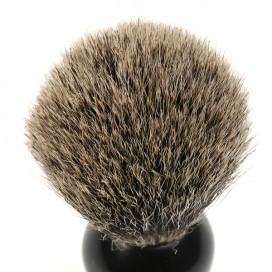Shaving brush
Shaving brush is a tool used by individuals during the process of shaving to apply shaving cream, shaving soap, or shaving foam onto the face or wherever shaving is intended. The shaving brush is also instrumental in exfoliating the skin and thereby reducing the chance of ingrown hairs.
History[edit | edit source]
The use of a shaving brush can be traced back to the 18th century. Initially, these brushes were made with badger hair, a tradition that persists to this day among high-quality brushes. However, with advancements in materials technology and increased awareness of animal rights, synthetic fibers have also become popular as an alternative to natural hair.
Types of Shaving Brushes[edit | edit source]
Shaving brushes can be categorized based on the type of bristle they use:
- Badger Hair Shaving Brushes: Known for their water retention capacity, these brushes are considered the gold standard. They are further classified into pure, best, super, and silvertip badger hair, with silvertip being the highest quality.
- Boar Hair Shaving Brushes: These brushes are stiffer than badger hair brushes and are often less expensive. They are excellent for exfoliating the skin.
- Synthetic Fiber Shaving Brushes: Made from man-made fibers, these brushes are animal-friendly and can vary in quality. High-quality synthetic brushes can mimic the softness and water retention of badger hair brushes.
- Horse Hair Shaving Brushes: Less common, these brushes are made from the mane or tail hair of horses. They are considered a middle ground between badger and boar hair in terms of softness and stiffness.
Usage[edit | edit source]
To use a shaving brush effectively:
- Wet the brush with warm water.
- Swirl the brush in the shaving soap or cream until a rich lather is formed.
- Apply the lather in a circular motion, which helps lift the hair and exfoliates the skin.
- Proceed with shaving.
After use, it is important to rinse the brush thoroughly and allow it to dry in an open space to prevent mildew and extend its lifespan.
Benefits[edit | edit source]
- Exfoliation: The action of the brush on the skin removes dead skin cells, reducing the risk of ingrown hairs and razor bumps.
- Richer Lather: A shaving brush aerates the shaving cream or soap, creating a richer and more luxurious lather than can be achieved by hand.
- Heat Retention: The lather retains heat from the warm water, which helps to open pores and soften hair, making for a closer and more comfortable shave.
Considerations[edit | edit source]
When choosing a shaving brush, consider the type of bristle, handle material, and size. The choice of bristle type affects the feel on the skin and the lather produced, while the handle material and size affect the grip and control during use.
Environmental Impact[edit | edit source]
The rise of synthetic shaving brushes offers an eco-friendly alternative to natural hair brushes, addressing concerns regarding animal welfare and sustainability. Additionally, using a shaving brush can reduce waste associated with canned shaving foams and gels.
| This article is a stub. You can help WikiMD by registering to expand it. |
Search WikiMD
Ad.Tired of being Overweight? Try W8MD's physician weight loss program.
Semaglutide (Ozempic / Wegovy and Tirzepatide (Mounjaro / Zepbound) available.
Advertise on WikiMD
|
WikiMD's Wellness Encyclopedia |
| Let Food Be Thy Medicine Medicine Thy Food - Hippocrates |
Translate this page: - East Asian
中文,
日本,
한국어,
South Asian
हिन्दी,
தமிழ்,
తెలుగు,
Urdu,
ಕನ್ನಡ,
Southeast Asian
Indonesian,
Vietnamese,
Thai,
မြန်မာဘာသာ,
বাংলা
European
español,
Deutsch,
français,
Greek,
português do Brasil,
polski,
română,
русский,
Nederlands,
norsk,
svenska,
suomi,
Italian
Middle Eastern & African
عربى,
Turkish,
Persian,
Hebrew,
Afrikaans,
isiZulu,
Kiswahili,
Other
Bulgarian,
Hungarian,
Czech,
Swedish,
മലയാളം,
मराठी,
ਪੰਜਾਬੀ,
ગુજરાતી,
Portuguese,
Ukrainian
Medical Disclaimer: WikiMD is not a substitute for professional medical advice. The information on WikiMD is provided as an information resource only, may be incorrect, outdated or misleading, and is not to be used or relied on for any diagnostic or treatment purposes. Please consult your health care provider before making any healthcare decisions or for guidance about a specific medical condition. WikiMD expressly disclaims responsibility, and shall have no liability, for any damages, loss, injury, or liability whatsoever suffered as a result of your reliance on the information contained in this site. By visiting this site you agree to the foregoing terms and conditions, which may from time to time be changed or supplemented by WikiMD. If you do not agree to the foregoing terms and conditions, you should not enter or use this site. See full disclaimer.
Credits:Most images are courtesy of Wikimedia commons, and templates, categories Wikipedia, licensed under CC BY SA or similar.
Contributors: Prab R. Tumpati, MD





